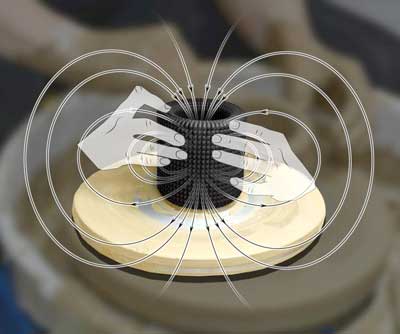| Mar 21, 2019 | |
Magnetic micro-boats(Nanowerk News) Nano- and microtechnology are promising candidates not only for medical applications such as drug delivery but also for the creation of little robots or flexible integrated sensors. |
|
| Scientists from the Max Planck Institute for Polymer Research (MPI-P) have created magnetic microparticles, with a newly developed method, that could pave the way for building micro-motors or guiding drugs in the human body to a target, like a tumor. The preparation of such structures as well as their remote-control can be regulated using magnetic fields and therefore can find application in an array of domains (ACS Nano, "Shaping the Assembly of Superparamagnetic Nanoparticles"). | |
 |
|
| Scientists can use a magnetic field to determine the structure that is formed by superparamagnetic nanoparticles. (Image: MPI-P, Lizenz CC-BY-SA) | |
| The magnetic properties of a material control how this material responds to the presence of a magnetic field. Iron oxide is the main component of rust but also – in another crystalline form - of the flat magnets that could be found on so many refrigerators. Those two forms of iron oxide have different magnetization and response to the presence of a magnetic field because of a change in how the small magnetic domains inside the material are oriented. | |
| On the nanometer scale – in the size range of approximately 30 millionth of a millimeter – when the size of the object is the same as the size of a magnetic domain, a new effect called “superparamagnetism” comes into play: superparamagnetic nanoparticles display high magnetization only in the presence of a magnetic field, they do not retain any magnetization when the magnetic field is removed. | |
| This reversible effect could be used in future medical applications, where drugs can be noninvasively guided in blood to a targeted site. However, when several of these nanoparticles aggregate to form larger structures – so-called clusters - they lose their superparamagnetic properties. Additionally, it is a technical challenge to create arbitrary shapes with such a material. | |
| In a collaboration between scientists from the group of Dr. Héloïse Thérien-Aubin in the department of Prof. Katharina Landfester specialized in the preparation of nanoparticles and scientist from the department of Prof. Hans-Jürgen Butt working on water-repellent surfaces, a new method has been established to solve these two problems. | |
| First, superparamagnetic nanoparticles made of iron-oxide were encapsulated in a protective shell made of polystyrene, a non-magnetic plastic, to preserve their superparamagnetism even during the formation of large aggregates. The protective shell acts in this case as a spacer between the nanoparticles. | |
| After the creation of these nanoparticles, the scientists put droplets consisting of superparamagnetic nanoparticles and water on a surface on which, like on a lotus leaf, water is repelled. Therefore, the drops form a spherical shape. After evaporation of the water, a three-dimensional structure consisting only of nanoparticles can be obtained. | |
| The researchers could show that they can vary the size and the shape of the resulting structure if they vary the concentration of the nanoparticles in water and use an external magnet while evaporating the water. Changing the concentration of the nanoparticles leads to different structure sizes from several micrometers to several millimeters. | |
| A variation of the power of the external magnetic field leads to different shapes, as the nanoparticles interact with the magnet and interact between themselves. | |
| With this preparation process, non-spherical structures, such as barrel-like, cone-like or two-tower-like, were obtained. “This represents a big step towards the use of superparamagnetic microstructures in applications, as our method is very versatile and very efficient in terms of time and material”, says Héloïse Thérien-Aubin. |
| Source: Max-Planck-Institut für Polymerforschung | |
|
Subscribe to a free copy of one of our daily Nanowerk Newsletter Email Digests with a compilation of all of the day's news. |
